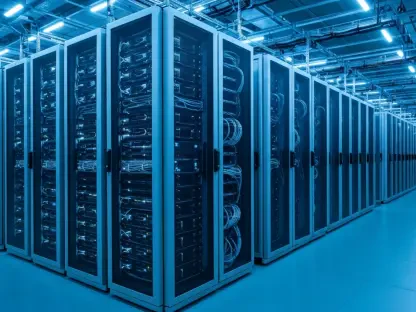Hyperscaler technology has emerged as a cornerstone of modern cloud computing, empowering businesses with access to immense computing power and storage capabilities, all while offering unprecedented scalability and efficiency. As enterprises increasingly embrace a “cloud-first” strategy, understanding the role and benefits of hyperscaler technology becomes essential for driving digital transformation. This article dives into the core of hyperscaler technology, examining how it revolutionizes cloud computing and significantly enhances business operations.
Defining Hyperscaler Technology
Hyperscaler technology is revolutionizing the way data centers operate by offering immense computing power and storage capabilities on a global scale. Unlike traditional data centers, hyperscalers are designed with scalability in mind, enabling them to expand resources seamlessly to meet varying demand levels. At the heart of hyperscaler technology lies a distributed network of hardware and software infrastructure, where millions of servers scattered across numerous geographical locations are interconnected by high-speed networks. This setup ensures optimal performance and reliability, serving as the backbone for a wide range of services such as database management, artificial intelligence (AI), machine learning, and big data analytics.
Essentially, hyperscalers are massive data centers created to support millions—even billions—of users worldwide. This immense scale is achieved by leveraging distributed computing principles and virtualization technologies, which allow for the efficient allocation of resources according to need. The ability to adapt swiftly to varying workloads means that businesses can deliver reliable and high-performance services on a global scale. By spreading tasks across multiple machines and integrating edge computing to process data closer to its source, hyperscalers reduce latency, boost processing speeds, and enhance overall service resilience.
Key Characteristics of Hyperscaler Technology
Hyperscaler technology is characterized by its ability to scale resources quickly and efficiently, ensuring that computing power and storage capacities can be adjusted to maintain optimal service levels during periods of varying demand. This scalable infrastructure is one of the key features that set hyperscalers apart from traditional data centers. When demand peaks, hyperscalers can seamlessly expand their resources, preventing interruptions or performance degradation. This level of flexibility is made possible through sophisticated virtualization technologies that enable the creation, scaling, and management of virtual machines. In a hyperscaler environment, workloads are evenly distributed across servers, which enhances performance and reduces the risk of bottlenecks, ensuring a smooth user experience.
Hyperscaler technology also leverages distributed computing principles to enhance efficiency and resilience. By spreading tasks across multiple machines, hyperscalers can mitigate downtime and process data more swiftly. Additionally, the integration of edge computing allows for data processing closer to its source, which significantly reduces latency and improves the performance of real-time applications. This combination of distributed and edge computing makes hyperscalers highly adaptable to various workloads and operational needs. The result is a robust and flexible infrastructure that can handle the demands of modern enterprises. Whether it’s global-scale services or complex AI-driven applications, hyperscalers provide the necessary computational power and storage to ensure optimal performance and reliability.
Advanced Technological Integration
A key component of hyperscaler technology is Software-Defined Networking (SDN), which centralizes control over network resources to allow for dynamic allocation and real-time adjustments to network traffic. This centralized control simplifies network management and significantly improves the performance of cloud services. SDN enables hyperscalers to efficiently route data, manage network congestion, and allocate resources as needed, ensuring that services remain reliable and high-performing. By decoupling network control from physical hardware, SDN offers a more flexible and scalable solution for managing extensive network infrastructures, which is crucial for the large-scale operations of hyperscalers.
Hyperscalers also harness the power of AI and machine learning to boost operational efficiency and reliability. These advanced technologies enable real-time resource allocation, predictive maintenance, and automated troubleshooting. With AI-driven insights, hyperscalers can optimize data center operations, ensuring seamless service delivery and minimizing the likelihood of downtimes. For instance, machine learning algorithms can predict potential hardware failures and automatically reroute workloads to prevent service disruptions. This proactive approach not only enhances performance but also significantly reduces operational costs by minimizing the need for manual intervention. In essence, the integration of AI and machine learning makes hyperscalers more adaptive, resilient, and efficient, ensuring they can meet the high demands of modern cloud computing.
Security Measures and Automation
Security is a paramount concern in hyperscaler technology, and multiple layers of security protocols are employed to safeguard critical data effectively. These protocols encompass a range of measures including encryption, multi-factor authentication, and regular security audits to ensure data remains secure and compliant with industry regulations. In addition to these standard practices, hyperscalers utilize sophisticated monitoring tools designed to detect and neutralize potential threats dynamically. These proactive measures ensure that data remains protected against unauthorized access and potential breaches, providing a secure environment for businesses to operate in.
Automation and orchestration play crucial roles in enhancing the agility and efficiency of hyperscaler operations. With automated processes, routine tasks such as system scaling and resource allocation are streamlined, allowing IT staff to focus on strategic initiatives rather than repetitive tasks. Orchestration tools coordinate these automated tasks to ensure they work harmoniously, supporting dynamic and efficient operations. Automation extends to the use of Application Programming Interfaces (APIs), which offer clients the capability to customize and automate their cloud services. Through APIs, businesses can tailor their cloud environments to meet specific needs, automating processes such as load balancing, scaling, and monitoring. This level of customization augments the flexibility and efficiency of cloud computing solutions, making hyperscaler technology an invaluable asset for modern enterprises.
Energy Efficiency and Sustainability
Hyperscaler technology has become a fundamental component of modern cloud computing, providing businesses with vast computing power and storage potential. It offers unparalleled scalability and efficiency, making it a critical enabler for companies adopting a “cloud-first” approach. As digital transformation becomes a priority, understanding the impact and benefits of hyperscaler technology is crucial. This technology not only transforms cloud computing but also significantly enhances overall business operations.
By leveraging hyperscaler technology, enterprises can access computing resources on demand, allowing them to scale their operations without significant investments in physical infrastructure. This flexibility supports rapid innovation and responsiveness to market changes, giving businesses a competitive edge. Moreover, hyperscalers offer sophisticated tools and services that streamline data management, analytics, and application development, further driving efficiency and productivity.
The ability to handle massive workloads efficiently makes hyperscaler technology indispensable for industries ranging from finance to healthcare. It ensures robust data security and compliance, critical for maintaining trust and adhering to regulatory standards. As organizations continue to migrate to the cloud, mastering hyperscaler technology will be essential for sustaining growth and staying competitive in a rapidly evolving digital landscape.









